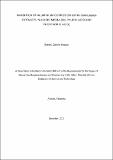| dc.description.abstract | Corrosion inhibition of aluminium using Carica papaya leaves extracts in 1M H2SO4 and IM H3PO4 was investigated under different temperatures (30, 40 and 500C) and concentrations (from 20-100 v/v %). The inhibitor was found to work by being adsorbed onto the aluminium surface, hence preventing the corrosion of the metal by forming a film that acted like a barrier to the direct contact between the metal and the acids. Gravimetric analysis (Weight loss method) as the main methodology was used throughout the investigation. From the data collected, inhibition efficiency values, adsorption isotherms, kinetic and thermodynamic parameters concerning the adsorption processes were determined; all of these give out important clues on the working ability of the inhibitor. Characterization was also applied using Scanning Electron Microscope (SEM) and Fourier Transform Infrared (FT-IR) spectroscopy. SEM was used to determine the adsorption ability of inhibitor by investigating aluminium coupons through surface profile analysis. The FT-IR machine was used to determine functional groups of the phytochemicals found in C. papaya leaves, inhibitor prepared and those participated in adsorption. Carica papaya leaves extract was found to have a maximum inhibition efficiency of 71.67 % and 56.02 % in H2SO4 and H3PO4 respectively, at the optimal concentration which ranges from 60 to 80 v/v % in both of the media used. Results obtained in this study give hope to corrosion engineers that C. papaya is among of the plants on which its extracts can be used to develop a commercialized natural corrosion inhibitor. This is possible because it has phytochemicals with active functional groups to develop inhibitive properties. | en_US |
